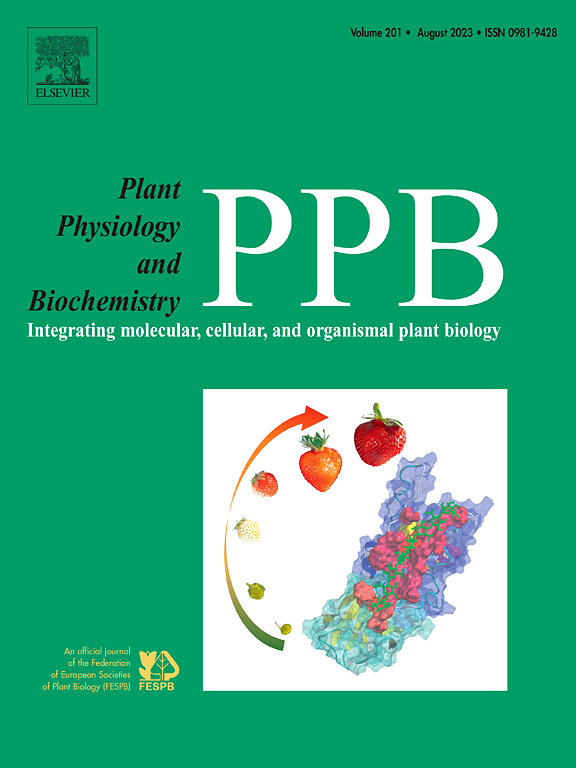Abscisic acid, stress andripening (ASR) proteins play a role in iron homeostasis in rice (Oryza sativa L.)
IF 6.1
2区 生物学
Q1 PLANT SCIENCES
引用次数: 0
Abstract
Iron (Fe) is essential for plant growth, playing a key role in photosynthesis, respiration, and nitrogen fixation. Despite its abundance, Fe is not easily available for uptake by roots, making Fe deficiency a common issue that reduces crop yields. The ASR (Abscisic acid/Stress/Ripening) proteins are known to be responsive to different abiotic stresses. Two ASR proteins from rice (Oryza sativa L.), OsASR1 and OsASR5, were described as transcription factors involved in aluminum (Al) toxicity response, and were shown to be partially redundant in their function. Here we explored a possible role of ASR proteins in Fe deficiency in rice plants. We showed that rice plants silenced for ASR genes (named OsASR5-RNAi) had increased sensitivity to Fe deficiency, with early and more severe chlorosis, as well as reduced photosynthesis, stunted growth, reduced seed set and altered ionome in roots, leaves and seeds. Transcriptomic analysis indicated that roots of OsASR5-RNAi plants had similar expression of Fe uptake genes, such as OsIRT1 and OsYSL15. However, long distance phloem transporter OsYSL2 was up-regulated in OsASR5-RNAi roots to a larger extent compared to WT, suggesting ASR proteins negatively regulate OsYSL2 expression. We also identified other interesting candidate genes, such as OsZIFL2 and Thionins, that are dependent on ASR proteins for regulation under Fe deficiency. Our work demonstrated that OsASR proteins are important for proper Fe deficiency response in rice.
脱落酸、胁迫和成熟(ASR)蛋白在水稻铁稳态中的作用
铁(Fe)对植物生长至关重要,在光合作用、呼吸作用和固氮作用中起着关键作用。尽管铁含量丰富,但它不容易被根系吸收,这使得缺铁成为降低作物产量的常见问题。已知ASR(脱落酸/应激/成熟)蛋白对不同的非生物胁迫有反应。来自水稻(Oryza sativa L.)的两个ASR蛋白OsASR1和OsASR5被描述为参与铝(Al)毒性反应的转录因子,并且在功能上被证明是部分冗余的。本研究探讨了ASR蛋白在水稻缺铁中的可能作用。我们发现,沉默ASR基因(OsASR5-RNAi)的水稻植株对缺铁的敏感性增加,出现更早和更严重的黄化,以及光合作用减少、生长发育迟缓、结实率降低和根、叶和种子的离子素改变。转录组学分析表明,OsASR5-RNAi植物的根系具有相似的铁摄取基因OsIRT1和OsYSL15的表达。然而,与WT相比,OsASR5-RNAi根中长距离韧皮部转运蛋白OsYSL2的上调幅度更大,表明ASR蛋白负向调节OsYSL2的表达。我们还发现了其他有趣的候选基因,如OsZIFL2和thiionins,它们依赖于ASR蛋白在缺铁情况下进行调节。我们的工作表明,OsASR蛋白对水稻适当的缺铁反应很重要。
本文章由计算机程序翻译,如有差异,请以英文原文为准。
求助全文
约1分钟内获得全文
求助全文
来源期刊
CiteScore
11.10
自引率
3.10%
发文量
410
审稿时长
33 days
期刊介绍:
Plant Physiology and Biochemistry publishes original theoretical, experimental and technical contributions in the various fields of plant physiology (biochemistry, physiology, structure, genetics, plant-microbe interactions, etc.) at diverse levels of integration (molecular, subcellular, cellular, organ, whole plant, environmental). Opinions expressed in the journal are the sole responsibility of the authors and publication does not imply the editors'' agreement.
Manuscripts describing molecular-genetic and/or gene expression data that are not integrated with biochemical analysis and/or actual measurements of plant physiological processes are not suitable for PPB. Also "Omics" studies (transcriptomics, proteomics, metabolomics, etc.) reporting descriptive analysis without an element of functional validation assays, will not be considered. Similarly, applied agronomic or phytochemical studies that generate no new, fundamental insights in plant physiological and/or biochemical processes are not suitable for publication in PPB.
Plant Physiology and Biochemistry publishes several types of articles: Reviews, Papers and Short Papers. Articles for Reviews are either invited by the editor or proposed by the authors for the editor''s prior agreement. Reviews should not exceed 40 typewritten pages and Short Papers no more than approximately 8 typewritten pages. The fundamental character of Plant Physiology and Biochemistry remains that of a journal for original results.

 求助内容:
求助内容: 应助结果提醒方式:
应助结果提醒方式:


